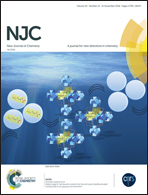NMOF self-templating synthesis of hollow porous metal oxides for enhanced lithium-ion battery anodes†
Abstract
Hollow porous Fe2O3 hexagonal nanorods were fabricated via a facile and controllable approach using MOFs (Fe-MIL-88A) as both precursors and sacrificial templates. It has been found that Fe(OH)3, which is formed on the surface of MOFs after treatment with NaOH solution, plays a significant role in maintaining its morphology during calcination. The interior of well-defined hollow porous Fe2O3 hexagonal nanorod structures is assembled by interconnected nanoparticles to form a porous structure. As anode materials for Li-ion batteries, the hollow porous Fe2O3 hexagonal nanorods exhibit long-term cycling stability (1219 mA h g−1 after 100 cycles) and ultrahigh rate capability. The high electrochemical performance is attributed to the unique structure and morphology of the hollow porous nanorods.



 Please wait while we load your content...
Please wait while we load your content...